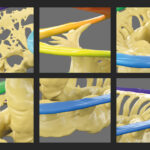
MED-EL
Published Aug 04, 2025
Cochlear Implantation in Meniere’s Disease: Clinical Insights on Timing and Perioperative Management
While the cause of Meniere’s disease (MD) remains an enigma, a review of recent literature provides some valuable findings to keep in mind when considering cochlear implant candidacy and care for patients with Meniere’s disease.

Meniere’s disease (MD) can be challenging to diagnose, manage, and treat due to fluctuating vestibular symptoms and progressive sensorineural hearing loss (SNHL). Prevalence increases with age, and onset is almost exclusively in adulthood.Harris, J. P., & Alexander, T. H. (2010). Current-Day Prevalence of Ménière’s Syndrome. Audiology and Neurotology, 15(5), 318–322. https://doi.org/10.1159/000286213[1] The initial symptoms of Meniere’s disease can be vertigo (37%), tinnitus (18%), fluctuating hearing loss (20%), or any combination of the three. Between 25 and 38% of MD cases begin with the full triad of symptoms.
Predominately low-frequency hearing loss, either reverse sloping (27%) or flat (55%), is common in the early stages. After five to ten years, speech discrimination declines to 50-60% in more than half of patients with Meniere’s disease, and it is estimated that Meniere’s disease leads to bilateral hearing loss in 47% of patients within 20 years.Huppert, D., Strupp, M., & Brandt, T. (2010). Long-term course of Menière’s disease revisited. Acta Oto-Laryngologica, 130(6), 644–651. https://doi.org/10.3109/00016480903382808[2]
While cochlear implantation (CI) is an established intervention for severe-to-profound SNHL, its role in MD patients has been historically underutilized and understudied. Despite this, recent evidence highlights two critical considerations for clinicians managing MD patients:
- MD-associated hearing loss often results in poorer speech recognition than comparable age-related hearing loss (ARHL), warranting earlier referral for CI evaluation.
- CI may confer additional benefits beyond auditory rehabilitation by improving vertigo control and other MD symptoms.
This review synthesizes current literature to inform clinical decision-making regarding CI candidacy and timing in MD.
Speech Recognition Deficits in Meniere’s Disease: Implications for Early Cochlear Implantation
Unlike individuals with ARHL, MD patients face unique challenges that set them apart from traditional hearing loss cohorts. Grant et al., 2022 reported that Meniere’s Disease patients exhibit significantly worse word recognition scores (WRS) than those with ARHL, even after controlling for audiometric thresholds.Grant, K. J., Parthasarathy, A., Vasilkov, V., Caswell-Midwinter, B., Freitas, M. E., Gruttola, V. de, Polley, D. B., Liberman, M. C., & Maison, S. F. (2022). Predicting neural deficits in sensorineural hearing loss from word recognition scores. Scientific Reports, 12(1), 8929. https://doi.org/10.1038/s41598-022-13023-5[3] (Please refer to graph C in figure 10 linked here.)
This discrepancy is attributed to underlying cochlear nerve degeneration (CND) and synaptic loss unique to MD pathology, which compromises neural encoding despite preserved hair cell function in some cases,Nadol, J. B. (1990). Degeneration of cochlear neurons as seen in the spiral ganglion of man. Hearing Research, 49(1–3), 141–154. https://doi.org/10.1016/0378-5955(90)90101-t[4]Momin, S. R., Melki, S. J., Alagramam, K. N., & Megerian, C. A. (2010). Spiral ganglion loss outpaces inner hair cell loss in endolymphatic hydrops. The Laryngoscope, 120(1), 159–165. https://doi.org/10.1002/lary.20673[5] thereby limiting auditory processing capabilities and potentially reducing the efficacy of conventional hearing aids.McRackan, T. R., Gifford, R. H., Kahue, C. N., Dwyer, R., Labadie, R. F., Wanna, G. B., Haynes, D. S., & Bennett, M. L. (2014). Cochlear implantation in Ménière’s disease patients. Otology & Neurotology : Official Publication of the American Otological Society, American Neurotology Society [and] European Academy of Otology and Neurotology, 35(3), 421–425. https://doi.org/10.1097/mao.0000000000000247[6]
Pure tone averages (PTA) have been taken as the first line indication for CI worldwide. However, speech perception with ≤50% sentence recognition is used as an additional requirement for reimbursement in most countries, except in Australia, where ≤65% speech perception in quiet is used.Heyning, P. V. de, Belgium, D. of E., Antwerp University Hospital, Antwerp, Gavilán, J., Godey, B., Hagen, R., Hagr, A., Kameswaran, M., Li, Y., Manoj, M., Mlynski, R., O’Driscoll, M., Pillsbury, H., Raine, C. H., Rajan, G., Schmutzhard, J., Staecker, H., Spain, M. H. L. P. P. de la C., Madrid, France, C.-C. H. U. de R., Rennes, Germany, W. E. U. H., Würzburg, … USA, K. U. C. for H. and B. D., Kansas City,. (2022). Worldwide Variation in Cochlear Implant Candidacy. The Journal of International Advanced Otology, 18(3), 196–202. https://doi.org/10.5152/iao.2022.21470[7] Additionally, some private insurers in the United States have extended the speech perception requirement to ≤60% in 2022.
The shift towards speech perception requirements reflects the recognition that many individuals with residual hearing and sentence understanding above 50% can still face significant difficulty in real-word environments. This is especially significant for patients with MD. Delaying CI in Meniere’s disease patients until profound hearing loss ensues risks prolonged periods of suboptimal auditory input, exacerbating social isolation and cognitive decline.
Therefore, evaluating CI candidacy early in MD patients is particularly meaningful, especially in cases with refractory tinnitus or significant vertigo that impacts quality of life.
A Paradigm Shift for Cochlear Implantation in Meniere’s Disease?

Significant Hearing Improvements
Cochlear implantation offers MD patients significant improvements compared to pre-CI across multiple metrics: speech discrimination improves, hearing thresholds stabilize, and auditory clarity enhances significantly. For patients with severe-to-profound hearing loss or unusable hearing, CIs provide a reliable, consistent auditory experience that markedly improves communication and functioning in daily life.
There are variations in the comparison between MD patients and non-MD patients. This may be related to the long duration before receiving a CI that is common among CI recipients with MD (up to 48 years).
- Many studies have demonstrated that Meniere’s disease patients with a cochlear implant developed comparable or above average auditory performance scores compared with non-MD patients, including SSD patients.Perkins, E., Rooth, M., Dillon, M., & Brown, K. (2018). Simultaneous labyrinthectomy and cochlear implantation in unilateral meniere’s disease. Laryngoscope Investigative Otolaryngology, 3(3), 225–230. https://doi.org/10.1002/lio2.163[8]Kanona, H., Forde, C., Rooyen, A. M. V., Keating, P., Bradley, J., Pendolino, A. L., Mehta, N., Manjaly, J. G., Khalil, S., Lavy, J., Saeed, S. R., & Shaida, A. (2022). Cochlear implant outcomes in patients with Meniere’s disease: a large case series. Cochlear Implants International, 23(6), 339–346. https://doi.org/10.1080/14670100.2022.2112998[9]
- Meanwhile, other studies have reported poorer performance compared with non-MD patients, especially when tested at lower sound intensity (55dB SPL).Wrobel, C., Bevis, N. F., Klinge-Strahl, A., Strenzke, N., & Beutner, D. (2022). Performance and self-perceived hearing impairment after cochlear implantation in Menière’s disease. Laryngoscope Investigative Otolaryngology, 7(1), 219–225. https://doi.org/10.1002/lio2.714[10]
Benefits Beyond Hearing: Meniere’s Disease & Cochlear Implantation
Beyond restoring hearing, CI demonstrates transformative effects on other MD-related symptoms:
- Vertigo Control: A significant proportion (55-100%) of MD patients report better vertigo control or complete resolution of vertigo episodes post-CI.Berardino, F. D., Conte, G., Turati, F., Ferraroni, M., & Zanetti, D. (2020). Cochlear implantation in Ménière’s disease: a systematic review of literature and pooled analysis. International Journal of Audiology, 59(6), 406–415. https://doi.org/10.1080/14992027.2020.1720922[11]Spiegel, J. L., Weiss, B. G., Mueller, J., Hempel, J.-M., Rader, T., Bertlich, M., Canis, M., & Ihler, F. (2023). Significance of endolymphatic sac surgery with and/or without simultaneous cochlea implant surgery in respect of vertigo control and speech perception in patients with Menière’s disease. European Archives of Oto-Rhino-Laryngology, 281(2), 1–9. https://doi.org/10.1007/s00405-023-08122-6[12]Kurz, A., Auinger, A., & Arnoldner, C. (2020). Long-term vertigo control after cochlear implantation in patients with end-stage Menière’s disease : A retrospective questionnaire-based cross-sectional study. Wiener Klinische Wochenschrift, 132(17–18), 521–525. https://doi.org/10.1007/s00508-019-01605-9[13] Coupling CI with vestibular procedures, such as labyrinthectomy or vestibular neurectomy, has shown particularly promising results in maintaining balance and alleviating dizziness.Sykopetrites, V., Giannuzzi, A. L., Lauda, L., Rubbo, V. D., Bassi, M., & Sanna, M. (2020). Surgical Labyrinthectomy and Cochlear Implantation in Menière’s Disease. Otology & Neurotology : Official Publication of the American Otological Society, American Neurotology Society [and] European Academy of Otology and Neurotology, 41(6), 775–781. https://doi.org/10.1097/mao.0000000000002646[14]
- Preventing Drop Attacks (Tumarkin’s Ototlithic Crisis): Often described as sudden falls without warning, drop attacks affect about 10% of MD patients and pose significant safety hazards. CI is effective in completely controlling these episodes, thereby improving patient autonomy and mobility.Filippi, C., Covelli, E., Elfarargy, H. H., Monini, S., & Barbara, M. (2023). The role of cochlear implantation in alleviating Tumarkin drop attacks of Meniere’s disease; a case report. Journal of Otology, 18(3), 168–172. https://doi.org/10.1016/j.joto.2023.06.002[15]
- Tinnitus Relief: Tinnitus, experienced by about 62% of MD patients, can be severely distressing. CI has been effective in reducing tinnitus severity by supplying stable auditory input, offering patients much-needed relief.Villavisanis, D. F., Mavrommatis, M. A., Berson, E. R., Bellaire, C. P., Rutland, J. W., Fan, C. J., Wanna, G. B., & Cosetti, M. K. (2021). Cochlear Implantation in Meniere’s Disease: A Systematic Review and Meta-Analysis. The Laryngoscope, 131(8), 1845–1854. https://doi.org/10.1002/lary.29393[16]
- Enhanced Quality of Life: The collective impact of improved hearing, reduced vertigo, and tinnitus relief fosters better QoL outcomes. MD patients report significantly higher satisfaction with life post-CI, including enhanced emotional well-being, social participation, and workplace productivity.Sanchez-Cuadrado, I., Calvino, M., Morales-Puebla, J. M., Gavilán, J., Mato, T., Peñarrocha, J., Prim, M. P., & Lassaletta, L. (2021). Quality of Life Following Cochlear Implantation in Patients With Menière’s Disease. Frontiers in Neurology, 12, 670137. https://doi.org/10.3389/fneur.2021.670137[17]
Clinical Considerations for Cochlear Implantation in Meniere’s Disease Patients
Timing and Candidate Selection
Given the evidence of poorer speech recognition and progressive neural injury in MD, clinicians should consider earlier CI referral rather than waiting for profound hearing loss. This is especially pertinent for patients exhibiting:
- Fluctuating but moderate SNHL with disproportionate speech discrimination deficits.
- Severe tinnitus refractory to medical therapy.
- Frequent or disabling vertigo attacks impacting communication and daily functioning.
Early multidisciplinary evaluation involving audiologists, otologists, and vestibular specialists can facilitate timely identification of candidates likely to benefit from CI.
Preoperative Evaluation and Counseling
Preoperative assessment should include comprehensive audiometry, speech recognition testing at various intensities, and vestibular function evaluation.
The following aspects should be mentioned along with preoperative evaluation results:
- CI can improve hearing and tinnitus, but there may be potential limitations due to neural degeneration, especially if there is a long time between MD onset and the operation.
- Intratympanic corticosteroids before CI may help preserve hearing and reduce fluctuations.Thangavelu, K., Gillhausen, F., Weiß, R. M., Mueller-Mazzotta, J., Stuck, B. A., & Reimann, K. (2024). Role of prior intratympanic gentamicin and corticosteroids therapy on speech understanding in patients with Menière’s disease after cochlear implantation. European Archives of Oto-Rhino-Laryngology, 281(7), 1–8. https://doi.org/10.1007/s00405-024-08449-8[18]
- Previous vestibular surgeries do not contraindicate CI and may improve QoL.
- There may be an improvement of vestibular symptoms post-CI.
- CI does not trigger MD symptoms in inactive patients.
- CI does not prevent MD progression in the contralateral ear.
- Auditory fluctuations and impedance variability can be expected and this may require extended cochlear implant fitting and rehabilitation.
Implantation side selection generally favors the worse hearing ear to preserve contralateral vestibular function, though bilateral implantation may be considered in select cases.
Surgical Approach and Electrode Choice
Round window insertion is preferred over cochleostomy to minimize trauma and reduce the risk of exacerbating endolymphatic hydrops. Electrode choice should balance hearing preservation goals with adequate cochlear coverage. However, new evidence demonstrates that MED-EL’s FLEX electrode design allows the majority of recipients to retain some functional residual hearing post-implantation, and the preservation of residual low-frequency hearing was proven with the MED-EL FLEX electrode portfolio, including long electrodes such as FLEX28 and FLEXSOFT.Heyning, P. H. V. de, Dazert, S., Gavilan, J., Lassaletta, L., Lorens, A., Rajan, G. P., Skarzynski, H., Skarzynski, P. H., Tavora-Vieira, D., Topsakal, V., Usami, S., Rompaey, V. V., Weiss, N. M., & Polak, M. (2022). Systematic Literature Review of Hearing Preservation Rates in Cochlear Implantation Associated With Medium- and Longer-Length Flexible Lateral Wall Electrode Arrays. Frontiers in Surgery, 9, 893839. https://doi.org/10.3389/fsurg.2022.893839[19]
Simultaneous CI and vestibular ablative procedures require careful surgical planning but have demonstrated favorable outcomes without increased complications.
Postoperative Management
Clinicians should anticipate:
- The possible auditory fluctuations and impedance changes necessitating frequent mapping adjustments.
- The potential need for prolonged audiological follow-up and vestibular rehabilitation.
- The contralateral MD development should be monitored, although CI does not appear to influence disease progression in the opposite ear.
Cochlear Implantation: An Underutilized Treatment Option for Meniere’s Disease
Meniere’s disease often starts on one side, leading to single-sided deafness and distressing tinnitus. Watch how a cochlear implant transformed Helen’s life.
Cochlear implantation represents a vital yet underutilized treatment option for patients with Meniere’s disease. The documented poorer speech recognition in MD compared to ARHL supports reconsideration of current CI candidacy thresholds, advocating for earlier intervention to mitigate the impact from neural degeneration and improve communication outcomes.
Additionally, CI may provide meaningful relief of vestibular symptoms, either alone or in combination with ablative surgeries, enhancing overall patient quality of life.
“I didn’t realize how much I was missing out in life. I love riding my bike and getting out in nature, which are things I haven’t felt very safe doing with my hearing loss. My MED-EL cochlear implant also silenced my tinnitus, which is really quite amazing and a huge relief.”
Helen, Audiologist from Australia
Clinicians managing MD are encouraged to maintain a high degree of caution and consideration for individual characteristics when assessing cochlear implant candidacy. Proactive multidisciplinary collaboration can optimize timing and therapeutic strategies. Further prospective studies are needed to refine protocols and elucidate mechanisms underlying CI’s dual auditory and vestibular benefits in this complex patient population.
References
-
[1]
Harris, J. P., & Alexander, T. H. (2010). Current-Day Prevalence of Ménière’s Syndrome. Audiology and Neurotology, 15(5), 318–322. https://doi.org/10.1159/000286213
-
[2]
Huppert, D., Strupp, M., & Brandt, T. (2010). Long-term course of Menière’s disease revisited. Acta Oto-Laryngologica, 130(6), 644–651. https://doi.org/10.3109/00016480903382808
-
[3]
Grant, K. J., Parthasarathy, A., Vasilkov, V., Caswell-Midwinter, B., Freitas, M. E., Gruttola, V. de, Polley, D. B., Liberman, M. C., & Maison, S. F. (2022). Predicting neural deficits in sensorineural hearing loss from word recognition scores. Scientific Reports, 12(1), 8929. https://doi.org/10.1038/s41598-022-13023-5
-
[4]
Nadol, J. B. (1990). Degeneration of cochlear neurons as seen in the spiral ganglion of man. Hearing Research, 49(1–3), 141–154. https://doi.org/10.1016/0378-5955(90)90101-t
-
[5]
Momin, S. R., Melki, S. J., Alagramam, K. N., & Megerian, C. A. (2010). Spiral ganglion loss outpaces inner hair cell loss in endolymphatic hydrops. The Laryngoscope, 120(1), 159–165. https://doi.org/10.1002/lary.20673
-
[6]
McRackan, T. R., Gifford, R. H., Kahue, C. N., Dwyer, R., Labadie, R. F., Wanna, G. B., Haynes, D. S., & Bennett, M. L. (2014). Cochlear implantation in Ménière’s disease patients. Otology & Neurotology : Official Publication of the American Otological Society, American Neurotology Society [and] European Academy of Otology and Neurotology, 35(3), 421–425. https://doi.org/10.1097/mao.0000000000000247
-
[7]
Heyning, P. V. de, Belgium, D. of E., Antwerp University Hospital, Antwerp, Gavilán, J., Godey, B., Hagen, R., Hagr, A., Kameswaran, M., Li, Y., Manoj, M., Mlynski, R., O’Driscoll, M., Pillsbury, H., Raine, C. H., Rajan, G., Schmutzhard, J., Staecker, H., Spain, M. H. L. P. P. de la C., Madrid, France, C.-C. H. U. de R., Rennes, Germany, W. E. U. H., Würzburg, … USA, K. U. C. for H. and B. D., Kansas City,. (2022). Worldwide Variation in Cochlear Implant Candidacy. The Journal of International Advanced Otology, 18(3), 196–202. https://doi.org/10.5152/iao.2022.21470
-
[8]
Perkins, E., Rooth, M., Dillon, M., & Brown, K. (2018). Simultaneous labyrinthectomy and cochlear implantation in unilateral meniere’s disease. Laryngoscope Investigative Otolaryngology, 3(3), 225–230. https://doi.org/10.1002/lio2.163
-
[9]
Kanona, H., Forde, C., Rooyen, A. M. V., Keating, P., Bradley, J., Pendolino, A. L., Mehta, N., Manjaly, J. G., Khalil, S., Lavy, J., Saeed, S. R., & Shaida, A. (2022). Cochlear implant outcomes in patients with Meniere’s disease: a large case series. Cochlear Implants International, 23(6), 339–346. https://doi.org/10.1080/14670100.2022.2112998
-
[10]
Wrobel, C., Bevis, N. F., Klinge-Strahl, A., Strenzke, N., & Beutner, D. (2022). Performance and self-perceived hearing impairment after cochlear implantation in Menière’s disease. Laryngoscope Investigative Otolaryngology, 7(1), 219–225. https://doi.org/10.1002/lio2.714
-
[11]
Berardino, F. D., Conte, G., Turati, F., Ferraroni, M., & Zanetti, D. (2020). Cochlear implantation in Ménière’s disease: a systematic review of literature and pooled analysis. International Journal of Audiology, 59(6), 406–415. https://doi.org/10.1080/14992027.2020.1720922
-
[12]
Spiegel, J. L., Weiss, B. G., Mueller, J., Hempel, J.-M., Rader, T., Bertlich, M., Canis, M., & Ihler, F. (2023). Significance of endolymphatic sac surgery with and/or without simultaneous cochlea implant surgery in respect of vertigo control and speech perception in patients with Menière’s disease. European Archives of Oto-Rhino-Laryngology, 281(2), 1–9. https://doi.org/10.1007/s00405-023-08122-6
-
[13]
Kurz, A., Auinger, A., & Arnoldner, C. (2020). Long-term vertigo control after cochlear implantation in patients with end-stage Menière’s disease : A retrospective questionnaire-based cross-sectional study. Wiener Klinische Wochenschrift, 132(17–18), 521–525. https://doi.org/10.1007/s00508-019-01605-9
-
[14]
Sykopetrites, V., Giannuzzi, A. L., Lauda, L., Rubbo, V. D., Bassi, M., & Sanna, M. (2020). Surgical Labyrinthectomy and Cochlear Implantation in Menière’s Disease. Otology & Neurotology : Official Publication of the American Otological Society, American Neurotology Society [and] European Academy of Otology and Neurotology, 41(6), 775–781. https://doi.org/10.1097/mao.0000000000002646
-
[15]
Filippi, C., Covelli, E., Elfarargy, H. H., Monini, S., & Barbara, M. (2023). The role of cochlear implantation in alleviating Tumarkin drop attacks of Meniere’s disease; a case report. Journal of Otology, 18(3), 168–172. https://doi.org/10.1016/j.joto.2023.06.002
-
[16]
Villavisanis, D. F., Mavrommatis, M. A., Berson, E. R., Bellaire, C. P., Rutland, J. W., Fan, C. J., Wanna, G. B., & Cosetti, M. K. (2021). Cochlear Implantation in Meniere’s Disease: A Systematic Review and Meta-Analysis. The Laryngoscope, 131(8), 1845–1854. https://doi.org/10.1002/lary.29393
-
[17]
Sanchez-Cuadrado, I., Calvino, M., Morales-Puebla, J. M., Gavilán, J., Mato, T., Peñarrocha, J., Prim, M. P., & Lassaletta, L. (2021). Quality of Life Following Cochlear Implantation in Patients With Menière’s Disease. Frontiers in Neurology, 12, 670137. https://doi.org/10.3389/fneur.2021.670137
-
[18]
Thangavelu, K., Gillhausen, F., Weiß, R. M., Mueller-Mazzotta, J., Stuck, B. A., & Reimann, K. (2024). Role of prior intratympanic gentamicin and corticosteroids therapy on speech understanding in patients with Menière’s disease after cochlear implantation. European Archives of Oto-Rhino-Laryngology, 281(7), 1–8. https://doi.org/10.1007/s00405-024-08449-8
-
[19]
Heyning, P. H. V. de, Dazert, S., Gavilan, J., Lassaletta, L., Lorens, A., Rajan, G. P., Skarzynski, H., Skarzynski, P. H., Tavora-Vieira, D., Topsakal, V., Usami, S., Rompaey, V. V., Weiss, N. M., & Polak, M. (2022). Systematic Literature Review of Hearing Preservation Rates in Cochlear Implantation Associated With Medium- and Longer-Length Flexible Lateral Wall Electrode Arrays. Frontiers in Surgery, 9, 893839. https://doi.org/10.3389/fsurg.2022.893839
References

MED-EL
Was this article helpful?
Thanks for your feedback.
Sign up for newsletter below for more.
Thanks for your feedback.
Please leave your message below.
CTA Form Success Message
Send us a message
Field is required
John Doe
Field is required
name@mail.com
Field is required
What do you think?
The content on this website is for general informational purposes only and should not be taken as medical advice. Please contact your doctor or hearing specialist to learn what type of hearing solution is suitable for your specific needs. Not all products, features, or indications shown are approved in all countries.

MED-EL

MED-EL




